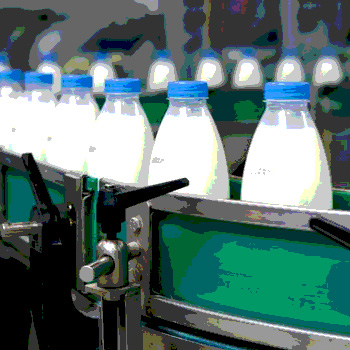Putting Rapid Methods to the Test for the Dairy Industry

Dairy products that are not consumed quickly face unique challenges. They need to taste and smell fresh when they reach consumers, yet traditional testing for contamination typically requires holding products for up to 2 weeks.
Fortunately, today’s leading dairy manufacturers have discovered the benefits of rapid detection of microbial contaminants. A rapid screening can provide reliable, reproducible results in as few as 48 hours, reducing product hold times by 2–12 days, and resulting in significant economic benefits.
Testing and releasing in-spec products in only 2 days—instead of filling quarantined inventory holding space with up to 2 weeks’ worth of production output awaiting test results (plus replacement and safety stock) —frees up valuable space inside the warehouse. It releases up to 10 days’ worth of invested working capital and shortens the cash cycle so your company gets paid faster. Rapid screening also reduces the impact of contamination events by detecting potential out-of-spec batches faster.
To fully realize the economic and productivity benefits of a rapid screening system, it is important to understand the information your company needs in order to perform most efficiently and effectively. When a rapid system is selected to answer a business need, such as releasing product faster, you will be able to select the best system for your company and more quickly realize a return on your investment.
Shortening the Production Cycle with Lean Quality
Slow and unreliable testing methods—such as post-production tear-downs, pH monitoring and traditional agar plating—tie up millions of dollars each year in working capital and excess inventory requirements. These methods also cause a delayed and more expensive response to contaminations when they do occur. Fortunately, “lean manufacturing” initiatives have made their way into most industries, stripping waste and non-value-adding steps from the production process and saving companies millions. But why stop there? “Lean quality” extends the same principles to microbial testing.
Rapid microbial screening with ATP bioluminescence has emerged as an industry standard. This is an ideal lean alternative to traditional monitoring methods for aseptic, Ultra Heat Treated (UHT) or extended shelf life (ESL) dairy and nut milk products. With results in as few as 48 hours, ATP screening enables companies to keep their safety standards high and their cost of quality low.
How Rapid Methods Work
To ensure quality and safety, products that are susceptible to microbial contamination but expected to be shipped contamination-free are screened before being released into distribution. A well-validated adenosine triphosphate (AT) rapid method can deliver reliable results in as few as 48 hours by detecting ATP, present in all living organisms. Product samples are treated with a proprietary reagent that reduce non-microbial sources of ‘background’ ATP and then cause a reaction with any existing microbial ATP. If the reaction occurs it generates a photon of yellow-green light (similar to that of a firefly), which is read by a luminometer or light recording instrument. A rapid screening of sample products quickly and accurately detects any with potential contamination, allowing the vast majority of production to be released to market rapidly and efficiently.
Selecting the Right Rapid Method
Achieving fast and accurate results are possible only when the right rapid method is implemented. Dairy and dairy-related product manufacturers of aseptic UHT or ESL products should consider these five criteria when selecting a rapid method for their facility:
Actionable Information
The more quickly a rapid microbial screening method can help you make an important business decision, the greater the financial value you will realize. A simple, rapid test that provides a positive or negative result is all that’s needed for the vast majority of today’s aseptic and functionally sterile production runs. Rapid presence/absence primary screening will reveal which lots can be quickly moved to distribution and which require further evaluation.
System Performance
A rapid microbial method should process samples efficiently with minimal input. The ideal rapid method is easy to use, processes samples in a resource-efficient manner, and allows for ‘walk-away’ automation. Look for a rugged, robust, accurate instrument with high sample throughput that is also small enough to conserve valuable lab space.
Support
To obtain maximum efficiencies from a rapid screening system, look for a provider that offers comprehensive services as well as scientific and technical support. Critical items to consider when evaluating support are:
• Validation expertise and support
• Experience with similar product types in the dairy, food and beverage industries
• Application development facilities and capabilities
• Global customer support and technical services
• Rapid response times
• System optimized for minimal system downtime
• Regulatory compliance assistance
• Data integration for track-and-trace reporting
• Financial model estimating ROI
Compliance
Rapid microbial screening software should track, trace, and provide controlled access to data. Be sure the system provides a database that is customizable to a company’s unique requirements and is able to track samples in a way that meets federal or local regulatory requirements. The database should be designed to integrate with existing laboratory information management and enterprise resource planning systems, and easily export valuable reporting information to common spreadsheet and database programs, such as Excel or Access. Secure, remote access to testing data will make it easier for lab management to generate reports and monitor the system from any location on the network.
Continuous Improvement
To be successful, companies in the dairy industry and their suppliers must adapt to ever-changing products and market requirements. It is important that the rapid method provider is committed to continuous improvement. Key activities to look for include investments in instrumentation and software, a range of reagent kits, method optimization to reduce downtime, ISO certification and in-house laboratories that assist in application development.
The Opportunity of Rapid Methods
With a solid understanding of the key considerations in selecting a rapid method, manufacturers of packaged dairy and nut milk products can capitalize on the full benefits of rapid microbial screening—faster, more reliable microbial results, improved manufacturing efficiencies, reduced inventory requirements, increased customer responsiveness and faster time-to-market.
The benefits add up to ongoing quality assurance with significant, bottom-line savings for today’s progressive dairy companies.
Scott Scdoris is the director, food and beverage, Celsis. For more information, please visit www.celsis.com.
Looking for a reprint of this article?
From high-res PDFs to custom plaques, order your copy today!





